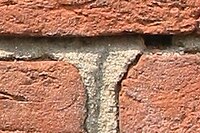
Photo from wikipedia
Abstract The present work is focused on a thorough experimental campaign to assess the thermo-physical properties and performance of mortar containing phase change materials (PCMs) with peak melting temperature of… Click to show full abstract
Abstract The present work is focused on a thorough experimental campaign to assess the thermo-physical properties and performance of mortar containing phase change materials (PCMs) with peak melting temperature of 34 °C. This selected melting temperature was targeted to reduce the peak temperature developed in mortar at early ages, induced by heat of hydration of cement. Indeed, 34 °C is well above normal casting temperatures, yet well below peak temperatures normally attained in massive concrete structures: therefore, this choice would represent a somewhat generalizable choice for attenuating peak temperatures. Due to experimental constraints, the tests conducted herein were performed on mortar (smaller size specimens are possible). However, the methods and findings may easily be extrapolated to concrete. New preparation and incorporation protocols have been considered for using PCMs into mortar: (i) grated pristine PCM to be dispersed into mixtures; and (ii) macro capsule core of PCM. Three PCM volume fractions of 0, 10 and 20% using the two above mentioned different strategies of incorporation into the mortar were used to prepare a total of five mortar test prototypes. Furthermore, mechanical tests were then carried out on companion specimens to evaluate the effect of incorporating PCM on the compressive and flexural strengths. The addition of grated PCM (i.e. shredded) in mortar led to enhancement of volumetric heat capacity while maintaining acceptable structural strength. The results revealed that the addition of PCM reduces density, thermal conductivity, and mechanical strength. In respect to the strength reduction, such percentages of incorporation were found to be small enough ( As expected the tested PCM mortar specimens had a lower peak temperature, as compared to that of the reference specimens (mortar without PCM). Indeed, the 20% dispersed PCM mixture allowed peak temperature to decrease from ∼52 °C to ∼44.8 °C. Complementarily, numerical models were developed and calibrated using the experimental data. The comparison between numerical simulation (using DIANA software) and experimental results revealed a very good agreement of the temperature profiles in the early ages. This allows to validate the capacity of simulating temperature evolution within mortar containing PCM, as well as, to understand the contribution of PCM to reduce the temperature rise coupled with the cement hydration phenomenon. It also represents a baseline methodology for scientists and practitioners to perform parametric analyses for other situations.
Journal Title: Construction and Building Materials
Year Published: 2019
Link to full text (if available)
Share on Social Media: Sign Up to like & get
recommendations!